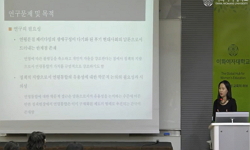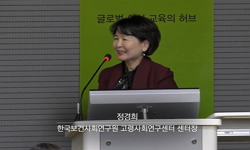사람들은 나이에 따라 사회적 위치가 달라지고, 경제활동이나 정치적 태도, 문화적 경험, 그에 따른 사회적 정체성과 행동양식까지도 변한다. 그래서 연령은 사회과학 연구에서 가장 중요한...
http://chineseinput.net/에서 pinyin(병음)방식으로 중국어를 변환할 수 있습니다.
변환된 중국어를 복사하여 사용하시면 됩니다.
- 中文 을 입력하시려면 zhongwen을 입력하시고 space를누르시면됩니다.
- 北京 을 입력하시려면 beijing을 입력하시고 space를 누르시면 됩니다.
https://www.riss.kr/link?id=A100090687
- 저자
- 발행기관
- 학술지명
- 권호사항
-
발행연도
2014
-
작성언어
Korean
-
주제어
연령 ; 연령구간 ; 사회적 지원 연결망 ; 생애 사건 ; 역할관계 ; Age ; Social Roles and Positions ; Life Course ; Social Support Networks ; Age Categories
-
등재정보
KCI등재
-
자료형태
학술저널
- 발행기관 URL
-
수록면
1-22(22쪽)
- 제공처
-
0
상세조회 -
0
다운로드
부가정보
국문 초록 (Abstract)
사람들은 나이에 따라 사회적 위치가 달라지고, 경제활동이나 정치적 태도, 문화적 경험, 그에 따른 사회적 정체성과 행동양식까지도 변한다. 그래서 연령은 사회과학 연구에서 가장 중요한 기본 속성 중 하나다. 그러나 많은 분석 과정에서 연령은 그 중요성에 비해 지나치게 단순한 방식, 즉 5년, 10년 등의 등구간 범주로 사용되고 있다. 사회구조 안에서 발생하는 생애 사건들과 그에 따른 역할관계의 변화를 연령이라는 변수에 담아내기 위해서는, 나이에 따른 사회적 관계 변화를 반영하는 연령 구간을 구성하는 것이 필요하다. 이를 위해 이 글에서는 사회적 도움이 필요한 세 가지 상황에서 누구에게 어떤 지원을 요청하는가를 바탕으로 사회적 지원 연결망을 구성하고, 이 연결망이 연령에 따라 어떻게 변하는가를 분석하여 새로운 연령 구분선을 그어 보았다. 2004년 한국인의 사회적 지원 연결망은 배우자와 친한 친구로 구성된 중심층과, 부모·자식·형제로 구성된 중간층, 여타 주변층으로 이루어진다. 연결망의 구성은 연령에 따라 달라졌는데, 혼인기에 배우자가 등장하여 중심층을 이루다가 노년기에 사라지고, 나이가 들수록 부모와 친구의 비중은 줄어드는 대신 자녀와 이웃의 비중이 늘어나는 등 한국인의 생애주기를 보여주었다. 이 변화를 기준으로 판별분석을 통해 연령구간을 재구성했다. 이렇게 재구성한 연령구간은 정치적 태도나 사회적 지원 행위, 가족과 친구에 대한 가치관과 같이 나이에 따라 변하는 준거변수들에서 연령구간별 차이를 기존의 방법에 비해 보다 명확히 드러내보였다.
다국어 초록 (Multilingual Abstract)
Age is one of the key indicators reflecting person’s social role and position. What they mark socially changes through the life course and is shaped by the social structures and norms therein. The ways in which age is typically employed in the socia...
Age is one of the key indicators reflecting person’s social role and position. What they mark socially changes through the life course and is shaped by the social structures and norms therein. The ways in which age is typically employed in the social science research, however, do not account for this variable yet discrete nature ? either by treating it as a continuous and linear variable or a categorial variable with arbitrarily assigned intervals. It should denote and distinguish different statuses of life course and social positions. To illustrate the issue, we reconstruct age categories based on theoretical and empirical grounds: social network theory and social support network data from KGSS 2004, respectively. In the analysis, we find the following: 1) The social support network of Koreans shows a three-tiered hierarchical structure with core (spouse and close friends), middle (parents, children, siblings, children, and neighbors), and periphery strata (the others). 2) Shape and content of the social network change through the life course, which could be categorized into six stages. The new categorization shows better ? statistically stronger and substantively cleaner ? performance with regard to some of criteria variables (political attitude, behavior of social support, values for family and friends).
목차 (Table of Contents)
- Ⅰ. 문제제기
- Ⅱ. 설정
- Ⅲ. 자료와 변수
- Ⅳ. 분석
- Ⅴ. 요약 및 논의
- Ⅰ. 문제제기
- Ⅱ. 설정
- Ⅲ. 자료와 변수
- Ⅳ. 분석
- Ⅴ. 요약 및 논의
- 참고문헌
동일학술지(권/호) 다른 논문
-
- 한국사회학회
- 유형근(Hyung-Geun Yoo)
- 2014
- KCI등재
-
- 한국사회학회
- 이병훈(Byoung-Hoon Lee)
- 2014
- KCI등재
-
- 한국사회학회
- 김수한(Soohan Kim)
- 2014
- KCI등재
-
한국 정치적 현대성의 젠더화된 구조와 가내성(家內性)의 정치적 부상
- 한국사회학회
- 구자혁(Ja Hyouk Koo)
- 2014
- KCI등재






 KCI
KCI DBpia
DBpia





